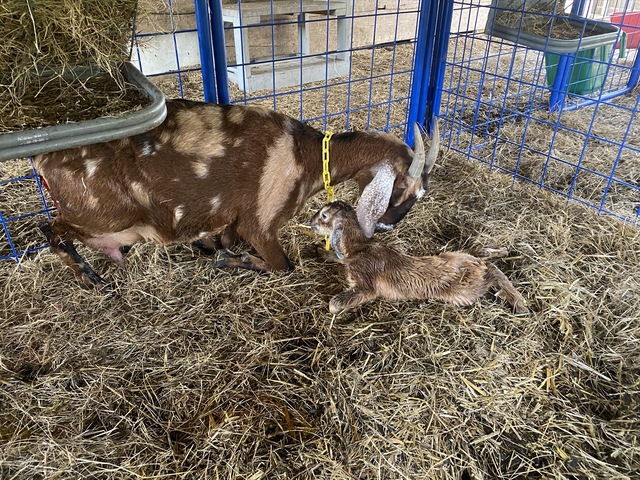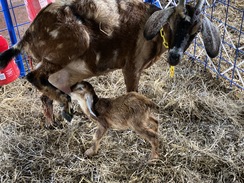Kidding, Dam Raising and Milking
Dairy Goats Doing What Dairy Goats Do!
Kidding
(If you are looking for a goat please fill out the Babka Farms 2023 Waitlist)
There is so much to know about kidding. Every time a doe kids there is a chance for something new to happen. I'm "becoming an expert" and by no means there yet. I don't think you can ever learn enough about this important topic. My goal is to share some videos of births we have had here at Babka Farms and our practices. I have some links to share so you can continue your own learning and develop the practices at your farm.
*Of course, I am not a vet. Develop a relationship with a local vet, especially for emergencies.
Pre-Kidding:
Birthing Mix - The purpose is to improve overall condition for labor and delivery by supporting uterine contractions. Additionally tone muscles, provide vitamins/minerals, and help prevent miscarriage. I look for one with raspberry and fennel. I've used Molly's Herbals, Fir Meadows, and Land of Havilah. Molly's is my favorite and my does favorite. I was going to make my own mix this year but when using up a bag from last year I noticed how easy it is to put a little on top of their feed and how quickly the devour it first.
Selenium - I use a product called KopSel from FirMeadows. I put this out free choice (sometimes mixed with kelp so it won't blow away). In my first two years kidding I had some kids born with weak legs/tendons. Apparently my area has a selenium deficiency. I've only had it happen to one kid since and it is easily corrected with selenium/vitamin e administered to the kid.
Hay and Feed Transition - Starting about a month before kidding I add in increasing amounts of alfalfa to the Timothy or grass hay they have been getting 24/7. I begin with a handful of chaffehay/alfahay. I increase this based on the firmness of their droppings. If I increase too quickly they get soft, clumpy or runny poo. I begin adding in grain at this time too, starting with about 2 Tbs and increasing to about a cup just prior to kidding.
Routine - In order get the right amount of feed to each doe, depending on her due date, I start putting them into birthing stalls at night around a month before kidding. This very practical practice has had some great value added benefits. 1.) at night in winter the herd tends to congregate in the leanto. It's a smaller space that results in some additional head butting. Putting my most pregnant does in kidding stalls protects them. 2.) They learn what stall belongs to them and it gets very easy to put them up for the night. They are also more comfortable going into the stall when labor begins. I've actually had does stand in front of their stall to let me know they are ready to begin kidding. 3.) When ligaments are gone and kids have dropped I put the doe in her stall with a buddy in the stall next to her so she can kid in her own space. 4.) Sometime I miss the signs and kids are born in the corral. Since the doe knows which stall is hers it has been easy to move her and the newborn kids to the stall afterwards.
Minerals - I increase the access to the 15 minerals to weekly (rather than 1-2 times a month).
Kidding:
The Doe - I try to put the doe in her own stall so she has some space. As noted above they do sometimes kid in the corral. The other goats don't really seem to bother them, but I want to avoid "kid stealing" by another doe who's hormones make her feel like she needs a baby. I give the doe access to hay, alfalfa, the birthing mix (see above), fresh water, and a buddy in the stall next to her.
The Shepherd (me) - I pray and watch the doe. How is she reacting to the contractions. Is she exhibiting pre-kidding behaviors (see video on my YouTube channel)? Is she calm or panicking? Is she just loud, or does it sound like she is in extra pain? I have been blessed with very normal birthing experiences. I have only had to go in to reposition and pull a kid once. I have gone into check a few more times. I have assisted in pulling a properly positioned (huge single buckling) a few times. I tend toward "letting nature take it's course" in the most informed way possible. I don't want a doe or kid to suffer because I didn't intervene. However, I have experienced that most of the time the birth will happen. Those contractions and body systems during birth are powerful and usually going to get that kid born healthy. I look for kids to be born about 20-30 minutes apart. I look for pushing to be productive. This is IMPORTANT. When pushing there should be evident progress when the kid starts presenting. If you just see two little hooves (or one) that repeatedly pokes out and retracts back in over the course of several pushes then you probably have a head/leg that is not presenting correctly. In that case I would go in and check to see if I need to reposition the kid.
Birthing Philosophy - As mentioned I tend to hang back and let the doe proceed through her labor (in an informed way to ensure health and safety for doe and kids). This may or may not match your practices. There are many other ways to attend to your does in kidding. My belief is that by letting the doe proceed I have a greater chance she will bond strongly with her kids. Contrarily, intervening too much may result in rejection and me adopting a bottle baby. I also think in trying to "help" I may make it worse. After all, the doe can't talk and what seems like help to me may not be helping her at all. For these reasons I stay very alert when attending the birth, love on the dam (many want extra attention), and am prepared at all time to assist if needed. Your approach is personal and you should research, experience and develop confidence in your preferred method to shepherd your herd.
Post Kidding:
I make a tea out of the birthing mix (see above), molasses, and herbal wormer to offer warm to the doe just after kidding. I also put a feeder with the 15 minerals in the stall with the dam right after she kids. I keep it there for a few days or until she shows no interest.
I let the dam clean the kids - as long as the kids are breathing and coughing (to clear fluid) on their own. I will clear fluid and ensure goop is not near their face to inhibit good first breaths of fresh air. I really try to help the kids find the udder very quickly to get that colostrum. Definitely within the first hour. On my YouTube channel you can see a video of Faith as a first freshener. It is clear by her expressions during labor that she is not quite on board with the "motherhood" thing yet. I was concerned she might reject her kid. You can see in the pictures below her lovingly licking him and her awkward semi cooperative first nursing about 15 minutes after he was born. She came around and is a wonderful mother!
Hay and Feed - I make sure the dam has an appetite and is eating. They get a serving of alfalfa and about 1 cup of grain with some sunflower seeds (BOSS) which they usually eat quite enthusiastically. I put out fresh hay afterwards and replenish their water.
Parasites - Check and recheck and recheck over the next few weeks for signs of parasites. I do fecals, FAMACHA, and body condition evaluations. The stress of kidding and lactation often results in a parasite bloom. Our practices have reduced, but not eliminated this issue. We are encouraged that our herd management is building our does resistance and resilience to parasite, but remain on alert at times of stress like kidding. See links below for some helpful resources.
Babka Farms YouTube Playlist - Kidding
Videos of pre-kidding behaviors and a few births at Babka Farms.
Babka Farms YouTube Playlist - Feeding and Supplementing
Videos of our various feeding and supplementing routines
Blue Cactus Dairy GoatsYouTube Channel
She has great videos, I go here to keep learning on many topics. With over 500 videos she has alot to offer.
Facebook Groups - check files for pictures of Kid presentations and birthing kit supplies
- Goat Emergency Team
- Goat Vet
Dam Raising
I do love dam raising, watching the bonding and how they integrate into the herd. I primarily want the kids to benefit from the milk that the dam specifically creates for the nutritional needs of her kids. A strong second is the joy of watching the kid "learn how to goat" from the dam. The podcast noted below on the Nutritional Wisdom of Goats expanded my appreciation of how comprehensively and beautifully the dam/kid relationship benefits the herd for generations to come. Now that I want to start milk testing I'm considering doing a 2 week period of dam raising and teaching how to take a bottle. Followed by a kid pen for the majority of the day and brief visits with their dam. This way I will easily be able to separate for milk test.
Podcast: For the Love of Goats: Nutritional Wisdom of Goats
Milking
This is another section I will add to as I go through the 2022 kidding season. In my breeding program I strive for does that are excellent for hand milking. However, I purchased a milking machine last season. So, let me process that for a little bit :)
I do, honestly prefer hand milking. I also work full time and have a few too many goats...There's an opportunity here, I will probably be selling some of my milkers to good homes this summer to get back to my preferred herd size.
Saturday, October 22, 2022


